10 Hacks to Burn More Fat While Walking, According to Scientist
Losing weight often feels like a daunting task. You've probably wondered, can something as simple as walking really make a difference? According to Dr. Miche, a research scientist with a PhD who specializes in weight loss, health, and fitness, the answer is a resounding yes.
Dr. Miche dives deep into the science to uncover the facts about walking for weight loss and fat burning. In this article, she shares 10 expert-backed hacks to help you burn more fat while walking. Read on to find out how small adjustments to your routine could help you achieve your fitness goals.
Hack 1: Walk Consistently to Lose Weight
Many wonder if walking, without any other lifestyle changes, can truly result in weight loss. Dr. Miche analyzed a meta-analysis involving over 1,100 participants who added walking to their daily routines. The participants walked four times a week for 40 minutes per session over 35 weeks.
"The results were impressive," explains Dr. Miche in her video. "On average, participants lost two pounds and reduced their body fat percentage by one point. This was achieved without any dietary changes." Even more remarkable, the control group, who did not walk, gained weight over the same period. "Not only does walking prevent age-related weight gain, but it also results in a net weight loss of about five pounds compared to those who don't walk," she adds.
The study also found other benefits of walking, including a reduction in blood pressure and improved cardiovascular fitness. "This means walking isn't just good for weight loss; it's great for your overall health," Dr. Miche notes.
Hack 2: Choose Walking Over Running for Fat Burn
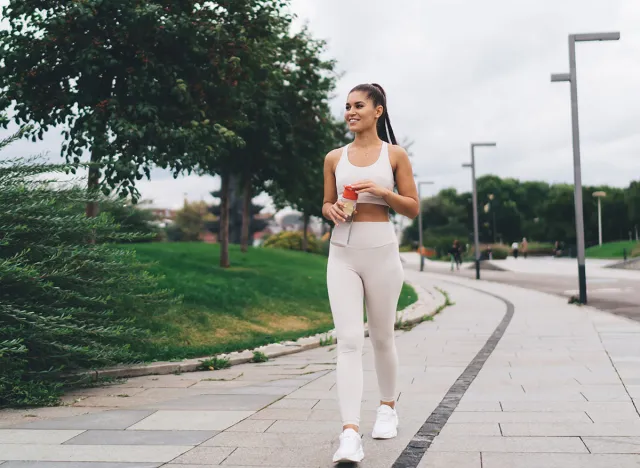
To see how walking stacks up against other exercises, researchers compared it to running and biking. Participants engaged in 30-minute sessions three times a week over 20 weeks, with intensity levels matched as closely as possible.
"Surprisingly, the walking group lost just as much weight as the running group and more than the biking group," says Dr. Miche. "In terms of body fat percentage, walking led to a reduction of three points, more than double what running or biking achieved."
Dr. Miche explains that this phenomenon is due to the intensity level. "Lower-intensity activities like walking tend to burn a higher percentage of fat compared to higher-intensity exercises like running," she elaborates. "It's the perfect example of how consistent, moderate activity can deliver impressive results."
RELATED: CDC Warns of Norovirus Outbreak Across the US as "Stomach Bug" Cases Rise
Hack 3: Walk at the Right Intensity

If you want to optimize your walking routine, Dr. Miche highlights an essential tip from a study on fat oxidation. "The sweet spot for fat burning occurs at about 60% of your maximum heart rate," she says. To estimate this, subtract your age from 220 and aim for 60% of that number during your walks.
For those who prefer not to calculate, Dr. Miche provides a simple guideline: "The study found that men achieved peak fat burning at an average walking speed of 3.4 miles per hour, while women's optimal speed was about 3 miles per hour."
Hack 4: Walk Regularly for Long-Term Benefits
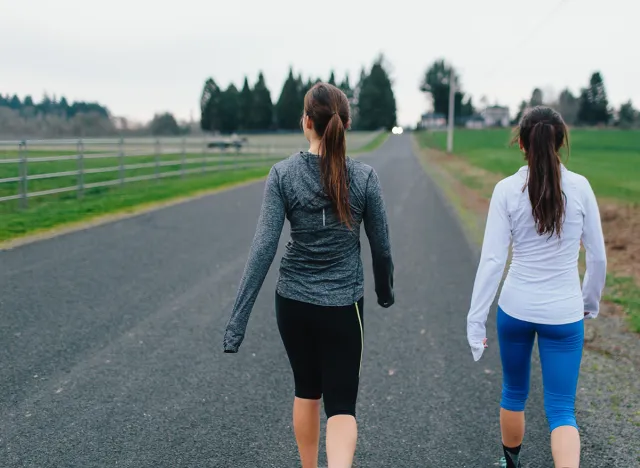
"Walking isn't just a short-term fix," notes Dr. Miche. "Over time, it helps you maintain your weight and prevent many chronic conditions." She highlights studies showing that regular walking reduces the risk of heart disease, diabetes, and even depression.
"Even small changes add up," Dr. Miche adds. "By walking consistently, you're setting yourself up for a healthier future, one step at a time."
Hack 5: Curb Your Appetite With Walking
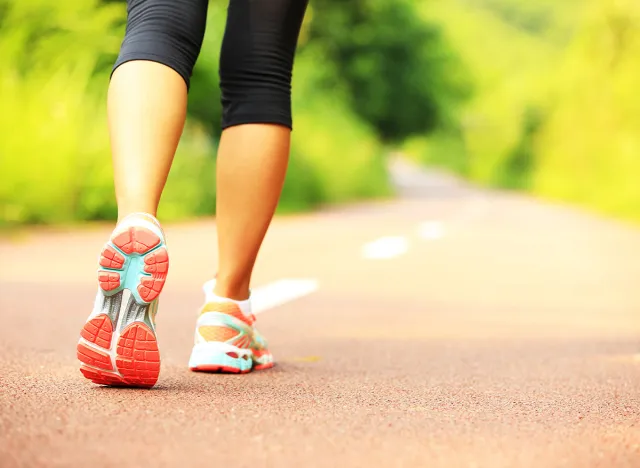
An often-overlooked benefit of walking is its impact on appetite regulation. "Walking can help moderate your hunger hormones," says Dr. Miche. "Unlike intense workouts that sometimes increase appetite, walking often has a neutral or even suppressive effect on hunger."
This means you're less likely to overeat after a walking session. "It's another reason walking is such a sustainable weight-loss tool," she explains.
Hack 6: Fit Walking Into Your Busy Schedule
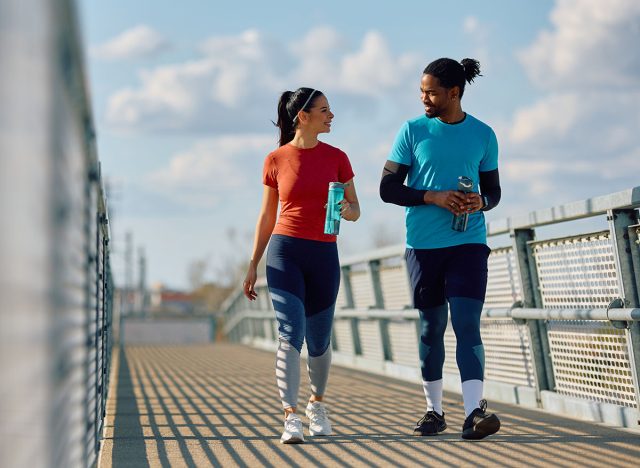
"One of the best things about walking is how flexible it is," says Dr. Miche. She suggests breaking up your walking sessions into smaller chunks if you're short on time. "Even 10-minute walks throughout the day can add up to significant health benefits."
She also recommends making walking a part of your daily routine. "Walk to the store, take the stairs, or enjoy a walk after dinner. These small changes make a big difference over time."
RELATED: Woman Lost 72 Pounds in 6 Months with Semaglutide, "I'm Ready to Date Again!"
Hack 7: Try Outdoor Walks for Extra Perks
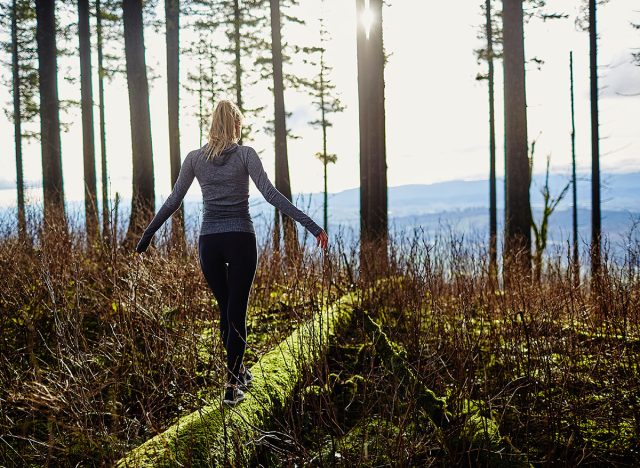
"Both options are great," Dr. Miche says. "Walking outdoors offers fresh air and natural scenery, which can boost your mood. On the other hand, a treadmill provides a controlled environment where you can adjust speed and incline."
She encourages choosing whichever option you enjoy more. "The key is consistency. If you like what you're doing, you're more likely to stick with it."
Hack 8: Pair Walking With Other Healthy Habits

"Walking is even more effective when combined with other healthy behaviors," Dr. Miche points out. She suggests pairing your walks with a balanced diet and good sleep hygiene. "These habits work together to amplify your results."
She also emphasizes the importance of hydration. "Staying hydrated supports your energy levels and helps your body function at its best during exercise."
Hack 9: Track Your Walking Progress

"Tracking your steps, distance, or time can be incredibly motivating," says Dr. Miche. She recommends using a pedometer, smartphone app, or fitness tracker to monitor your activity.
"Seeing your progress over time reinforces your efforts and helps you stay consistent," she explains. "Set achievable goals and celebrate small milestones along the way."
RELATED: 10 Protein Tricks for Burning Fat You'll Love, From a Nutritionist
Hack 10: Stay Consistent With Your Routine

In addition to weight loss, walking offers numerous health benefits. It's simple, accessible, and doesn't require special equipment or gym memberships. "Walking is also gentle on your joints and easy to incorporate into your day," Dr. Miche points out. Whether you're walking in a park, on a treadmill, or around your neighborhood, it's a sustainable form of exercise for most people.
"The key is consistency," she says. "With regular effort, walking can help you lose fat, improve your health, and enhance your fitness." And if you enjoyed this article, don't miss 12-3-30 Walking Method: 20 Proven Tips to Lose Weight Faster.





